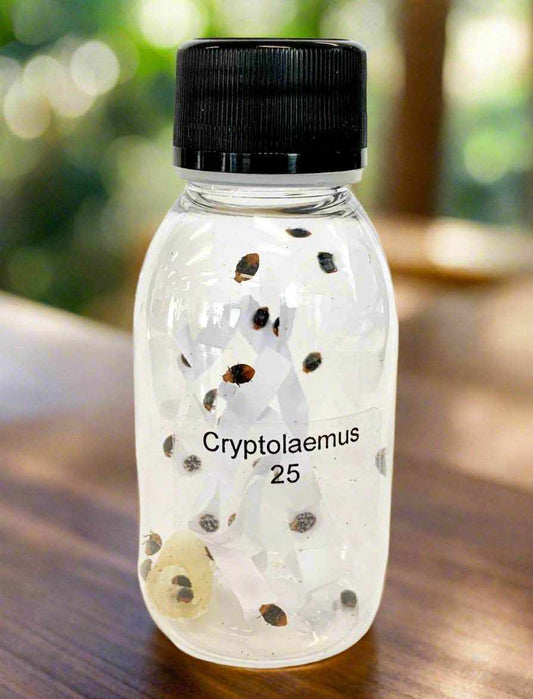Share
How to get rid of mealybugs on houseplants - 8 effective methods for natural control
Discover how to combat mealybugs with environmentally friendly methods that really work
Have you noticed white fluff on your houseplants? That white, cotton-like fluff that clings to leaves and stems is probably mealybugs, one of the most stubborn insect pests that attack our indoor green plants.
But before you give up hope for your beloved orchid or cactus, there is plenty of hope. With the right methods for aphid control, you can save your plants and create lasting protection against future infestations.

What are mealybugs and why do plants get mealybugs?
Mealybugs are small, white, oval insects that suck sap from plants. They belong to the scale family and measure only 2-6 millimeters. What makes them so easy to identify is the white, waxy coating that gives them a cotton-like appearance. This is why we often see white fluff on infested plants.

Woolly mammoths thrive in warm, dry environments, making our homes perfect habitats, especially during the winter when humidity is low and heat is high. They are particularly attracted to:
- Stressed or weakened plants
- Overwatered or underwatered houseplants
- Plants that are too close together
- Environments with poor air circulation
How do pubic lice spread?
Woolly aphids spread in several ways and it is important to understand this for effective control:
Through the air : Although adult mealybugs cannot fly in the traditional sense, the light young larvae (called "crawlers") can be dispersed by the wind.
Via clothing and tools : They easily attach to clothing, garden tools, and hands.
Between plants : They migrate from plant to plant when the pots are close together.
With new plants : New plants may already be infected when you buy them.
How long do pubic lice survive?
Woolly mammoths have a surprisingly fast life cycle that makes them a stubborn opponent. At 18°C, it only takes about 90 days from egg to adult. At 30°C, the life cycle is shortened to just 30 days. Adult females can lay 300-500 eggs over 5-10 days. Without food, they can survive for several weeks in a dormant state.
Recognizing mealybugs on houseplants
Early signs of mealybugs: White fluff mealybugs appear as small cotton balls in the leaf axils and sticky leaves from honeydew (a sweet secretion) can be noticed. Plants experience weak growth and yellowing leaves. On cacti, white fluff is often seen at the areoles (the attachment points of the thorns)

Pictures and identification: Woolly aphids look different depending on the species, but they all have a white, waxy covering that protects them. Females are globular and barely move, while males (which are rarely seen) can develop wings.
8 Effective Methods to Control Mealybugs
1. Biological control with beneficial animals: Cryptolaemus ladybugs
The most effective and environmentally friendly long-term method is to use beneficial insects. Cryptolaemus montrouzieri , also known as the 'wool aphid destroyer', is a small ladybug that specializes in eating wool aphids.
Benefits of Cryptolaemus: Adult ladybugs lay up to 400 eggs directly in the mealybug colonies. Both larvae and adults eat 30-70 mealybugs per day. The larvae resemble mealybugs and can sneak into the colonies. Ladybugs control all stages of mealybugs, from eggs to adults.

How to use Cryptolaemus:
Release the beneficial insects at the first sign of aphids. They have an optimal temperature: 22-25°C with 70-80% humidity. Avoid direct sunlight when releasing them. Ladybug activity decreases below 16°C or above 33°C.

You can buy ladybugs against mealybugs here.
2. Alcohol treatment, rapid emergency response
For emergency cases, you can use t-red. Dip a cotton swab in t-red alcohol. Then gently wipe off the mealybugs immediately. Repeat the treatment after a few days. Test on a small area first to make sure the plant can tolerate it.
3. Soap solution - mild and effective
Mix a mild soap solution: 1 tablespoon of dishwashing liquid per liter of water. Spray on affected areas. Then rinse off after 30 minutes.
4. Neem oil - natural protection
Neem oil is an excellent remedy for mealybugs: Mix according to the instructions on the package. Spray in the evening to avoid leaf damage as neem makes plants sensitive to light. Treat both the upper and lower sides of the leaves. Repeat every 7-14 days.
5. Isolation and quarantine
Move infested plants away from healthy ones immediately. Keep at least 2-3 meters away. Monitor other plants closely for several weeks. Reintroduce plants only when the plant is completely free of mealybugs.
6. Improved plant care
Strengthen the plants' natural defenses: Adjust watering, not too much or too little. Increase the humidity around the plants. Improve air circulation and provide the right amount of light for each plant species.
7. Physical removal
For light infestations: Use a soft brush or cotton swab. Then gently scrape off the mealybugs. Shower the plant with lukewarm water and check all the nooks and crannies.
8. Preventive measures
Inspect all new plants carefully before purchase. Keep new plants in a 2-3 week quarantine. Clean the leaves of your plants regularly. Avoid over-fertilizing which attracts pests.
Special treatment for different plant types
Orchid and mealybug
Orchids are particularly sensitive and require gentle treatment: Use a weaker solution of all pesticides. Focus on the undersides of the leaves and in the leaf axils. Biological control is often the best option. Be extra careful with the roots!
Cactus with white fluff
When you see white fluff on cactus: Use small brushes to get between the thorns. Alcohol treatment works surprisingly well on hard cactus surfaces. Beneficial insects such as ladybugs can be difficult to establish on cacti. Control with alcohol is the best treatment here!
When should you throw away the plant?
In some cases, it may be best to discard a severely infested plant: When more than 50% of the plant is covered in mealybugs, it is time to consider the soup. As well as if the plant is so weakened that it does not respond to treatment. When the risk of spread to other plants is too great or if biological control and other methods have repeatedly failed, the recycling station may be an alternative.
Long-term success with biological control
For best results, combine different methods:
- Emergency treatment : Alcohol or soap solution for immediate effect
- Biological control : Cryptolaemus for long-term control
- Preventive care : Optimal plant care for strong, resilient plants
- Regular monitoring : Detect new attacks early
Environmental awareness and sustainability
By choosing biological control and natural methods: You protect the environment from harmful chemicals. You create a natural ecosystem in your home and get long-term protection without resistance problems.

Summary
Aphids on houseplants don't have to mean the end of your green plants. With the combination of quick emergency treatment, biological control with beneficial insects such as Cryptolaemus, and improved plant care, you can effectively treat aphids and prevent future infestations.
Remember that early intervention is crucial, the faster you act when you see the first signs of white fuzz on plants, the easier it will be to control. Biological control offers the most durable and effective protection for your indoor plants in the long term.
Have you discovered mealybugs on your plants? Don't hesitate to take action immediately. With the right knowledge and tools, you can save your green plants and create an environment where they can thrive free from insect pests.






